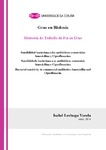Mostrar o rexistro simple do ítem
Sensibilidad bacteriana a los antibióticos comerciales Amoxicilina y Ciprofloxacino
| dc.contributor | Universidade da Coruña. Facultade de Ciencias | |
| dc.contributor.advisor | Torres, Enrique | |
| dc.contributor.author | Lechuga Varela, Isabel | |
| dc.contributor.other | Universidade da Coruña. Facultade de Ciencias | es_ES |
| dc.date.accessioned | 2018-10-18T10:45:21Z | |
| dc.date.available | 2018-10-18T10:45:21Z | |
| dc.date.issued | 2018 | |
| dc.identifier.uri | http://hdl.handle.net/2183/21169 | |
| dc.description.abstract | [Resumen]: Los fármacos comerciales antibacterianos se emplean para combatir infecciones que son producidas por bacterias. En este trabajo se pudo demostrar que el efecto de dos antibióticos de uso comercial (Amoxicilina y Ciprofloxacino) fue diferente en función de las bacterias ensayadas (Escherichia coli, Salmonella sp., Bacillus sp., Listeria sp. y Staphylococcus aureus). Estas bacterias mostraron diferente grado de sensibilidad a ambos antibióticos. Para calcular esta sensibilidad se ha empleado la técnica de la Concentración mínima inhibitoria (CMI). Además, se han obtenido los valores de la concentración del antibiótico que inhibe el 50 % del crecimiento bacteriano (IC50). Las especies más sensibles a la Amoxicilina fueron Bacillus sp. y Listeria sp. ambas con una CMI de 5 μg/mL pero con una IC50 de 2.805 μg/mL y 1.903 μg/mL, respectivamente. Las bacterias Escherichia coli y Salmonella sp. resultaron ser las más resistentes con una CMI de 10 μg/mL, y temiendo una IC50 de 7.047 μg/mL y 5.865 μg/mL, respectivamente. Con respecto al Ciprofloxacino, la especie más sensible fue Escherichia coli con una CMI de 0.06 μg/mL y una IC50 de 0.024 μg/mL, mientras que la bacteria Listeria sp. resultó ser la más resistente con una CMI de 0.375 μg/mL y una IC50 de 0.172 μg/mL. | es_ES |
| dc.description.abstract | [Abstract]: Commercial antibacterial drugs are used to fight infections that are caused by bacteria. In this work it was possible to demonstrate that the effect of two commercial antibiotics (Amoxicillin and Ciprofloxacin) was different depending on the bacteria tested (Escherichia coli, Salmonella sp., Bacillus sp., Listeria sp. And Staphylococcus aureus). These bacteria showed a different degree of sensitivity to both antibiotics. To calculate this sensitivity, the Minimum Inhibitory Concentration (MIC) technique has been used. Moreover, the values of the concentration of the antibiotic that inhibits 50% of bacterial growth (IC50) have been obtained. The species most sensitive to Amoxicillin were Bacillus sp. and Listeria sp. both with an MIC of 5 μg/mL but with an IC50 of 2.805 μg/mL and 1.903 μg/mL respectively. The bacteria Escherichia coli and Salmonella sp. they were the most resistant with a MIC of 10 μg/mL, and fearing an IC 50 of 7.047 μg/mL and 5.865 μg/mL respectively. With respect to Ciprofloxacin, the most sensitive species was Escherichia coli with an MIC of 0.06 μg/mL and an IC50 of 0.024 μg/mL, while the bacterium Listeria sp. It was found to be the most resistant with an MIC of 0.375 μg/mL and an IC50 of 0.172 μg/mL. | es_ES |
| dc.language.iso | spa | es_ES |
| dc.subject | Amoxicilina | es_ES |
| dc.subject | Ciprofloxacino | es_ES |
| dc.subject | Antibióticos | es_ES |
| dc.subject | Escherichia coli | es_ES |
| dc.subject | Staphylococcus aureus | es_ES |
| dc.subject | Bacillus | es_ES |
| dc.subject | Listeria | es_ES |
| dc.subject | Salmonella | es_ES |
| dc.subject | Inhibición | es_ES |
| dc.title | Sensibilidad bacteriana a los antibióticos comerciales Amoxicilina y Ciprofloxacino | es_ES |
| dc.title.alternative | Sensibilidade bacteriana a os antibióticos comerciais Amoxicilina e Ciprofloxacino | es_ES |
| dc.title.alternative | Bacterial sensitivity to commercial antibiotics Amoxicillin and Ciprofloxacin | es_ES |
| dc.type | info:eu-repo/semantics/bachelorThesis | es_ES |
| dc.rights.access | info:eu-repo/semantics/openAccess | es_ES |
| dc.description.traballos | Traballo fin de grao (UDC.CIE). Bioloxía. Curso 2017/2018 | es_ES |
Ficheiros no ítem
Este ítem aparece na(s) seguinte(s) colección(s)
-
Bioloxía, Grao en [438]






